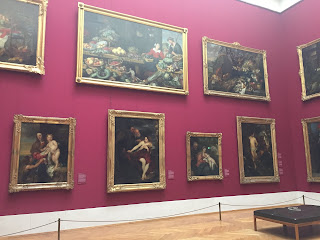 On Friday I went to see a rehearsal of the Carlos Acosta choreographed 'Don Quixote' with the Royal Ballet at the Royal Opera House. I quite like going to rehearsals since the tickets are ridiculously cheap, the show is fully staged (other than the band being in mufti) and you know you're there with real ballet enthusiasts. I've seen the traditional Petipa 'Don Quixote' danced by the Bolshoi a few years ago and, although I enjoyed it at the time, the memory hasn't lingered. I thought I'd give it another go and see the Acosta version and I'm so pleased I did.
On Friday I went to see a rehearsal of the Carlos Acosta choreographed 'Don Quixote' with the Royal Ballet at the Royal Opera House. I quite like going to rehearsals since the tickets are ridiculously cheap, the show is fully staged (other than the band being in mufti) and you know you're there with real ballet enthusiasts. I've seen the traditional Petipa 'Don Quixote' danced by the Bolshoi a few years ago and, although I enjoyed it at the time, the memory hasn't lingered. I thought I'd give it another go and see the Acosta version and I'm so pleased I did.  It's a gorgeous production (also down to Acosta) with lovely sets, lighting and costumes as well as great energetic dancing and continual movement on the stage. From the rather dark prologue the stage was suddenly bathed in incredibly warm light reflecting the sunlight of Spain as the cast throng the stage and mill about as dances start and the story starts to unfold. It was terribly exciting and made me want to see more and more and where was the good Don?
It's a gorgeous production (also down to Acosta) with lovely sets, lighting and costumes as well as great energetic dancing and continual movement on the stage. From the rather dark prologue the stage was suddenly bathed in incredibly warm light reflecting the sunlight of Spain as the cast throng the stage and mill about as dances start and the story starts to unfold. It was terribly exciting and made me want to see more and more and where was the good Don?Ah, that's the thing. Don Quixote is an old man and Sancho Panza is fat and middle aged so who does all the dancing? The young folks, of course, so the story isn't so much about the good Don but more about him enabling a story to progress. That story is the love between Kitri and Basilio and, after many adventures, he helps them to get married even though Kitri's father wants her to marry a local nobleman. It doesn't take long to realise that the good Don is an old romantic at heart that is on a quest to find his own love, the mysterious Dulcinea.
Sadly I don't know if the good Don finds his love or not since the Royal Ballet didn't dance Act Three. After the opening dance of Act Two the curtains closed and we were evacuated from the building due to a fire being reported somewhere in the building. After we got out, waited in the street and then got in again since it seems that the fire (if there was one) had been dealt with, we'd lost about an hour so there was only time available to dance Act Two.
That was disappointing but I'm so glad to have seen it - our lovers and the good Don meet with a band of gypsies in the countryside and we're treated to some marvellous flamenco dancing. Afterwards the Don attacks the evil windmill, gets knocked out and has a fever dream seeing the Dryads dance and that sequence was so beautiful to watch as the stage filled with ballerinas in tutus all dancing together in synchronised movements. Then we had to say goodbye since the Royal Opera House needed to get ready for the evening's performance.
Kitri was danced by Yasmine Naghdi and Basilio by Marcelino Sambe, with Matthew Ball dancing the famous matador and Beatriz Stix-Brunell as the street dancer. The romantic old fool, the good Don, was played by Christopher Saunders and Sancho by Philip Mosely. I want to see the whole thing again - including Act Three - so I've booked tickets to see it when it's broadcast live to cinemas on Tuesday this week. Most of the run is sold out or only has random seats available and I don't want to wait until April to see how this production concludes in Act Three.
Thank you Mr Acosta for breathing new life into a glorious story with amazing dances and opportunities for those young folk to shine.




















































